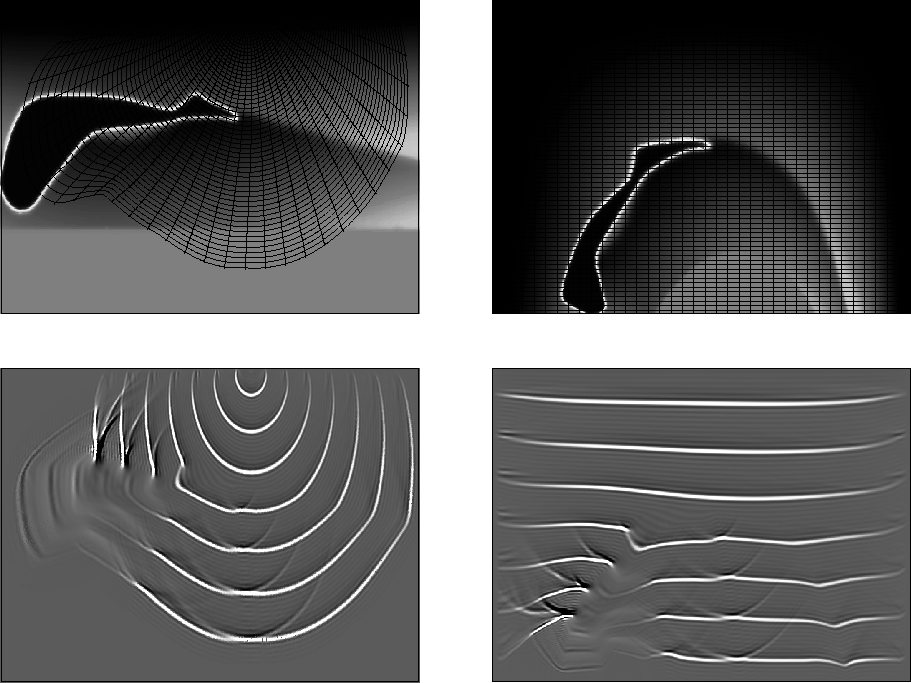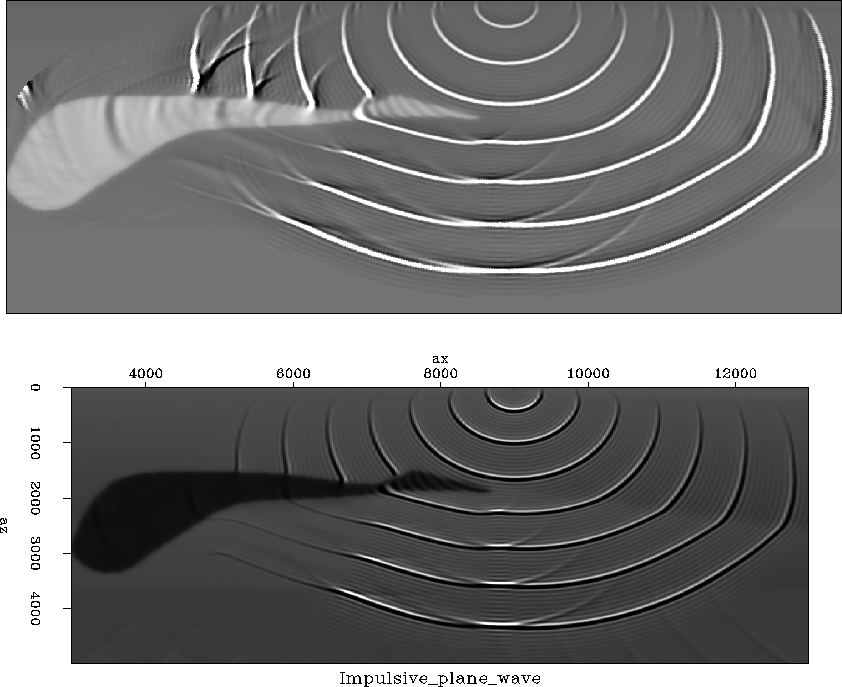




Next: Concluding Remarks
Up: Shragge: GRWE
Previous: Example 2 - Polar
The final test uses GRWE to generate estimates of Green's functions.
The test velocity model is a slice of the SEG-EAGE salt model (see
figure ![[*]](http://sepwww.stanford.edu/latex2html/cross_ref_motif.gif) ). The contrast between the salt
body and sediment velocities cause the wavefield to exhibit
complicated propagation including significant wavefield triplication
and multipathing. The upper left panel shows the velocity model with
an overlain coordinate mesh generated by the differential method
discussed in Shragge (2006a). The mesh is a
ray-based coordinate system because the first and last extrapolation
steps are formed by the 0.04 s and 2.25 s travel-time isochrons from a
first-arrival Eikonal equation solution. The velocity model in
the GRWE domain is illustrated in the upper right panel.
). The contrast between the salt
body and sediment velocities cause the wavefield to exhibit
complicated propagation including significant wavefield triplication
and multipathing. The upper left panel shows the velocity model with
an overlain coordinate mesh generated by the differential method
discussed in Shragge (2006a). The mesh is a
ray-based coordinate system because the first and last extrapolation
steps are formed by the 0.04 s and 2.25 s travel-time isochrons from a
first-arrival Eikonal equation solution. The velocity model in
the GRWE domain is illustrated in the upper right panel.
The lower right panel shows the impulse response test in the GRWE
domain. The 7 impulsive waves conform fairly well to the travel-time
steps, except where they enter the salt body to the lower left of the
image. The migration results mapped back to Cartesian space are shown
in the lower left panel. The wavefield to the left of the shot point
is fairly complicated and the energy in the salt body and the
corresponding upward refracted (and perhaps reflected?) wavefields are
strongly present.
SPexamp
Figure 5 Example of GRWE generated
Green's Functions on structured non-orthogonal mesh for a slice
through the SEG-EAGE Salt data set velocity model. Top left:
Salt model in physical space with an overlain ray-based mesh. Top
right: Velocity model in the GRWE domain. Bottom right: Wavefield
propagated in ray-coordinates through velocity model shown in the
upper right. Bottom left: Wavefield in bottom right
interpolated back to Cartesian space.





Figure ![[*]](http://sepwww.stanford.edu/latex2html/cross_ref_motif.gif) presents a comparison test between GRWE and
Cartesian extrapolation. Beneath and to the right of the shot point
the wavefields are fairly similar except for a phase-change. However,
they are significantly different to the left because Cartesian-based
extrapolation cannot propagate energy laterally with the same accuracy
and upward at all. Hence, this energy is absent from the wavefield in
the lower panel.
presents a comparison test between GRWE and
Cartesian extrapolation. Beneath and to the right of the shot point
the wavefields are fairly similar except for a phase-change. However,
they are significantly different to the left because Cartesian-based
extrapolation cannot propagate energy laterally with the same accuracy
and upward at all. Hence, this energy is absent from the wavefield in
the lower panel.
SPcompare
Figure 6 Results of a comparison test between
generalized Riemannian wavefield extrapolation (top panel) and
Cartesian-based extrapolation (bottom panel).










Next: Concluding Remarks
Up: Shragge: GRWE
Previous: Example 2 - Polar
Stanford Exploration Project
4/5/2006

![[*]](http://sepwww.stanford.edu/latex2html/cross_ref_motif.gif) ). The contrast between the salt
body and sediment velocities cause the wavefield to exhibit
complicated propagation including significant wavefield triplication
and multipathing. The upper left panel shows the velocity model with
an overlain coordinate mesh generated by the differential method
discussed in Shragge (2006a). The mesh is a
ray-based coordinate system because the first and last extrapolation
steps are formed by the 0.04 s and 2.25 s travel-time isochrons from a
first-arrival Eikonal equation solution. The velocity model in
the GRWE domain is illustrated in the upper right panel.
). The contrast between the salt
body and sediment velocities cause the wavefield to exhibit
complicated propagation including significant wavefield triplication
and multipathing. The upper left panel shows the velocity model with
an overlain coordinate mesh generated by the differential method
discussed in Shragge (2006a). The mesh is a
ray-based coordinate system because the first and last extrapolation
steps are formed by the 0.04 s and 2.25 s travel-time isochrons from a
first-arrival Eikonal equation solution. The velocity model in
the GRWE domain is illustrated in the upper right panel.
